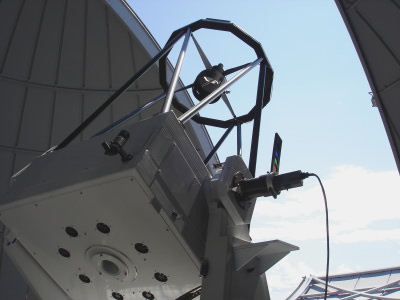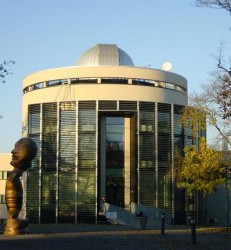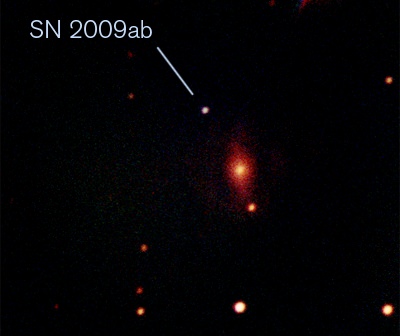[/caption]
SN 2009ab as seen by the AlbaNova Telescope in Stockholm, Sweden. Credit: Magnus Persson, Robert Cumming and Genoveva Micheva/Stockholm University
Have you ever discovered a supernova? Well, I haven’t, but I can only imagine finding a star that has blown itself to smithereens must be pretty exciting. At least that’s what I thought, anyway….
Seemingly, a fair amount of folks must be out there who have found supernovae. In 2008 alone, 278 supernovae were found, one by a 14-year old girl. But 2008 was a really slow year in the supernova department. In 2007, 584 were discovered – a record number – and in 2006, 557 supernovae were spied by astronomers, both professional and amateur. 40 have been found so far in 2009. But even with those fairly big numbers, I still gotta believe that finding a supernova must be absolutely incredible. So when someone I knew, Robert Cumming from Stockholm University in Sweden, recently played a part in finding a supernova, I emailed him my congratulations. Imagine my surprise when he replied, “It’s no big deal, really.”
But Robert, it’s a SUPERNOVA!
I had heard of Scandinavian stoicism, but this was off the charts! Besides that, I knew Robert is not originally from Sweden.
So, I begged him to tell me all about it.
“Well, since you ask,” he said with a smile. Okay, maybe, just maybe he was more excited than he was letting on.

Here’s the story of how Supernova 2009ab was discovered:
“I’ve observed a few supernovae before and I’ve had my name on the odd IAU circular, but this is the first time I’ve been one of the first to actually confirm one,” said Robert, with just a hint of excitement in his voice.
On February 8, the Katzman Automatic Imaging Telescope (KAIT), a 30-inch fully robotic telescope at the Lick Observatory on Mt. Hamilton in California discovered a bright spot not seen before in the outskirts of the spiral galaxy UGC 2998, 150 million light years away. Astronomers from KAIT wanted to make a second observation to verify, but bad weather made it impossible for them to confirm that the new object was not an asteroid or instrumental error. So, the KAIT astronomers requested observations from other telescopes around the world.
Magnus Persson, also from the Stockholm University was getting ready to do some observations using the University’s AlbaNova Telescope, when Robert received an email from KAIT about needing confirmation observations.

“I knew Magnus was going to be observing – he was planning to take some pictures of the Crab nebula for a colleague,” said Robert. “And I had this mail from the KAIT in California.”
So, the two set to work in an effort to locate the possible supernova.
Robert and Persson used different filters and took a few images of galaxy UGC 2998. “The supernova was right there on our first 45-second exposure – we were kind of amazed!” he said.
The two astronomers from Sweden were able to establish that the new light source showed all the signs of being a supernova. The supernova shines in a blue color, in contrast to the stars in the galaxy which are generally old and red, and the other stars in the image which lie in our galaxy. Shortly after the explosion, such a supernova emits as much energy as the entire host galaxy.
“We did the observations properly, and then I picked the best data to make very rough photometry, got comparison magnitudes from Gregor Dusczanowicz, Sweden’s amateur supernova discoverer, talked to a colleague to check we hadn’t forgotten anything important, and mailed off the measurements to the Central Bureau for Astronomical Telegrams.”
Other telescopes have now observed SN 2009ab, but the AlbaNova telescope was the first to successfully take images and confirm it as a new supernova. The following day, astronomers on the Canary Islands took a spectrum using the considerably bigger Telescopio Nationale Galileo and were able to determine the supernova was of type Ia, that is a white dwarf star which had exploded in a binary system. As Magnus’ and Robert’s confirmation was published in an astronomical telegram, the new supernova was named SN 2009ab, this year’s 28th supernova.
So, SN 2009ab is a story of the cooperative camaraderie that exists between astronomers, working together to verify and cross-check their findings. Here’s a list of everyone who contributed in the discovery of this supernova.
It’s also the story of a new telescope in an unlikely location being used to make new and exciting — yes exciting –discoveries. The Stockholm University Department of Astronomy uses the AlbaNova telescope, a 1-meter reflector, mainly for education and instrumental development. Robert said the plan is to use the telescope to do environmental monitoring, using LIDAR to monitor ozone and particle pollution in the city.
But Robert said the discovery of the supernova shows it is also possible to do scientifically interesting astronomical observations with the telescope, despite the limitations from Stockholm’s bad weather and light pollution.

“Our site is right in the city, so our sky brightness is scary. So far we haven’t measured just how bad it is, so it was a really nice surprise to get something out of it,” he said.
“The telescope is still pretty new, and with the Stockholm weather lately the experience of observing at all is pretty exciting,” Robert said. “And it is exciting that the telescope is now in full use. If we can do observations like these, we can do much more.”
So finally, I got Robert to admit he was excited. But the Scandinavian modesty and stoicism quickly returned.
“But the supernova itself is no big deal really, and our picture isn’t that good,” he said. “Many amateurs take pictures better than ours.”
Well, Robert, I’m excited for you! Congratulations!
Learn more about the AlbaNova Telescope.
Listen to Robert Cumming on the March 2 “365 Days of Astronomy” podcast, “Astrosvenska for Anyone: Space Swedish in Ten Ridiculously Short Lessons” (you’ll enjoy hearing his “Swedish” accent).
Robert Cumming also writes for a Swedish astronomy website, Populär Astronomi


Very pretty story Nancy !
Cuando pienso que alguna semana Nancy no puede sorprenderme, salta con una historia como esta y… bueno, es Universe Today otra vez.
Gracias!!!
You story reminds me of the amazing Rev. Robert (Bob) Evans in Australia, who has visually found forty-two supernovae since 1955 at last count. Rev. Evans has received many awards for his supernova searching, and has been honoured with the Order of Australia.
One huge advantage that he has is a photographic memory. He simply remembers each of the galaxy fields he observes – one after the other. The 12.5-inch (31cm) Newtonian telescope he observes with is on a Dobsonian mount, and can be rapidly view the sky. In a lecture I once heard him speak, he estimated he observed at a rate of 100 to 120 per hour! (One every thirty seconds!). It was calculated over 77 nights in one year, he sae 6814 galaxies in 6450 minutes of observing – 56 seconds per observation! He still continues to look for supernovae.
As your article says very well – visual observation regarding discovery is still quite possible (if your dedicated enough).
Of course now it can be done instrumentally and fairly quickly, via simple imaging, but the problem remains the time it takes to analyse the information.
In the end, the ability of the human mind to analyse, interpret and decide on the data available means visual discovery of supernova and variable stars, an comets, for example, will be made by amateur astronomers for many years to come.
I don’t think so. After all, big scopes need little scopes, too.
Congratulations, Robert! I’m just patiently waiting for that glorious moment when we amateur astronomers can finally see a supernova like Tycho Brahe’s from our favorite observing sites.
Grattis Robert, as we say it in swedish. I’m proud of having you as a friend! Riktigt stolt 🙂
I love the little right-angle finder on the big scope. That must be a joke!
Supernova can’t be a rare phenomena.
Given the estimated 100 billion galaxies in the known universe (which may be understated by a LOT), and the unfathomable number of stars (“1” followed by twenty one zeros, also probably understated), it is likely that in any given year there are many many millions of supernova going off somewhere. We still only have a relatively tiny number of astronomers, both professional and amateur, that are observing a miniscule, tiny portion all this at any given time. As the number of observers goes up each year, and the exponential increase in the sophistication in the technology continues, expect the number of supernova discovered to increase, well, “astronomically” in the future.
As well as discoveries that boggle the mind far beyond what we can even imagine at this time.
Stupid question: Are there any scopes North of the Arctic circle?
I think they have a telescope at the southern pole. Perfect if you have 6 months of night all day and night long 🙂
This story gives me the impression that the universe is like one of those Chinese firecracker bundles, snapping and popping off supernovae rapid-fire. This makes me smile.